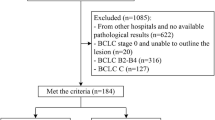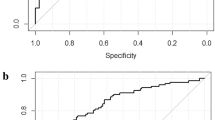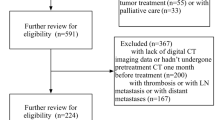Abstract
Purpose
To develop a CT-based radiomics signature and assess its ability for preoperatively predicting the early recurrence (≤1 year) of hepatocellular carcinoma (HCC).
Methods
A total of 215 HCC patients who underwent partial hepatectomy were enrolled in this retrospective study, and all the patients were followed up at least within 1 year. Radiomics features were extracted from arterial- and portal venous-phase CT images, and a radiomics signature was built by the least absolute shrinkage and selection operator (LASSO) logistic regression model. Preoperative clinical factors associated with early recurrence were evaluated. A radiomics signature, a clinical model, and a combined model were built, and the area under the curve (AUC) of operating characteristics (ROC) was used to explore their performance to discriminate early recurrence.
Results
Twenty-one radiomics features were chosen from 300 candidate features to build a radiomics signature that was significantly associated with early recurrence (P < 0.001), and they presented good performance in the discrimination of early recurrence alone with an AUC of 0.817 (95% CI: 0.758–0.866), sensitivity of 0.794, and specificity of 0.699. The AUCs of the clinical and combined models were 0.781 (95% CI: 0.719–0.834) and 0.836 (95% CI: 0.779–0.883), respectively, with the sensitivity being 0.784 and 0.824, and the specificity being 0.619 and 0.708, respectively. Adding a radiomics signature into conventional clinical variables can significantly improve the accuracy of the preoperative model in predicting early recurrence (P = 0.01).
Conclusions
The radiomics signature was a significant predictor for early recurrence in HCC. Incorporating radiomics signature into conventional clinical factors performed better for preoperative estimation of early recurrence than with clinical variables alone.




Similar content being viewed by others
References
Chen W, Zheng R, Baade PD, et al. (2016) Cancer statistics in China, 2015. CA Cancer J Clin 66(2):115–132. doi:10.3322/caac.21338
Clavien PA, Lesurtel M, Bossuyt PM, et al. (2012) Recommendations for liver transplantation for hepatocellular carcinoma: an international consensus conference report. Lancet Oncol 13(1):e11–e22. doi:10.1016/s1470-2045(11)70175-9
Bruix J, Reig M, Sherman M (2016) Evidence-based diagnosis, staging, and treatment of patients with hepatocellular carcinoma. Gastroenterology 150(4):835–853. doi:10.1053/j.gastro.2015.12.041
Sangiovanni A, Colombo M (2016) Treatment of hepatocellular carcinoma: beyond international guidelines. Liver Int 36(Suppl 1):124–129. doi:10.1111/liv.13028
Torzilli G, Donadon M, Marconi M, et al. (2008) Hepatectomy for stage B and stage C hepatocellular carcinoma in the Barcelona Clinic Liver Cancer classification: results of a prospective analysis. Archiv Surg (Chicago, IL: 1960) 143(11):1082–1090. doi:10.1001/archsurg.143.11.1082
Torzilli G, Belghiti J, Kokudo N, et al. (2013) A snapshot of the effective indications and results of surgery for hepatocellular carcinoma in tertiary referral centers: is it adherent to the EASL/AASLD recommendations? An observational study of the HCC East-West study group. Ann Surg 257(5):929–937. doi:10.1097/SLA.0b013e31828329b8
Hsu CY, Hsia CY, Huang YH, et al. (2012) Comparison of surgical resection and transarterial chemoembolization for hepatocellular carcinoma beyond the Milan criteria: a propensity score analysis. Ann Surg Oncol 19(3):842–849. doi:10.1245/s10434-011-2060-1
Yang T, Lin C, Zhai J, et al. (2012) Surgical resection for advanced hepatocellular carcinoma according to Barcelona Clinic Liver Cancer (BCLC) staging. J Cancer Res Clin Oncol 138(7):1121–1129. doi:10.1007/s00432-012-1188-0
Poon RT, Fan ST, Lo CM, Liu CL, Wong J (2002) Long-term survival and pattern of recurrence after resection of small hepatocellular carcinoma in patients with preserved liver function: implications for a strategy of salvage transplantation. Ann Surg 235(3):373–382
Shimozawa N, Hanazaki K (2004) Longterm prognosis after hepatic resection for small hepatocellular carcinoma. J Am Coll Surg 198(3):356–365. doi:10.1016/j.jamcollsurg.2003.10.017
Shah SA, Cleary SP, Wei AC, et al. (2007) Recurrence after liver resection for hepatocellular carcinoma: risk factors, treatment, and outcomes. Surgery 141(3):330–339. doi:10.1016/j.surg.2006.06.028
Poon RT, Fan ST, Ng IO, et al. (2000) Different risk factors and prognosis for early and late intrahepatic recurrence after resection of hepatocellular carcinoma. Cancer 89(3):500–507
Shimada M, Takenaka K, Gion T, et al. (1996) Prognosis of recurrent hepatocellular carcinoma: a 10-year surgical experience in Japan. Gastroenterology 111(3):720–726
Hosaka T, Ikeda K, Kobayashi M, et al. (2009) Predictive factors of advanced recurrence after curative resection of small hepatocellular carcinoma. Liver Int 29(5):736–742. doi:10.1111/j.1478-3231.2008.01901.x
Shah SA, Greig PD, Gallinger S, et al. (2006) Factors associated with early recurrence after resection for hepatocellular carcinoma and outcomes. J Am Coll Surg 202(2):275–283. doi:10.1016/j.jamcollsurg.2005.10.005
Li T, Qin LX, Gong X, et al. (2014) Clinical characteristics, outcome, and risk factors for early and late intrahepatic recurrence of female patients after curative resection of hepatocellular carcinoma. Surgery 156(3):651–660. doi:10.1016/j.surg.2014.04.008
Li T, Wang SK, Zhou J, et al. (2016) Positive HBcAb is associated with higher risk of early recurrence and poorer survival after curative resection of HBV-related HCC. Liver Int 36(2):284–292. doi:10.1111/liv.12898
Pawlik TM, Gleisner AL, Anders RA, et al. (2007) Preoperative assessment of hepatocellular carcinoma tumor grade using needle biopsy: implications for transplant eligibility. Ann Surg 245(3):435–442. doi:10.1097/01.sla.0000250420.73854.ad
Young AL, Lodge JP (2009) Needle-track seeding following biopsy of liver lesions in the diagnosis of hepatocellular cancer: a systematic review and meta-analysis. Gut 58(6):887–888
Segal E, Sirlin CB, Ooi C, et al. (2007) Decoding global gene expression programs in liver cancer by noninvasive imaging. Nat Biotechnol 25(6):675–680. doi:10.1038/nbt1306
Lambin P, Rios-Velazquez E, Leijenaar R, et al. (2012) Radiomics: extracting more information from medical images using advanced feature analysis. Eur J Cancer (Oxford, England: 1990) 48(4):441–446. doi:10.1016/j.ejca.2011.11.036
Aerts HJ, Velazquez ER, Leijenaar RT, et al. (2014) Decoding tumour phenotype by noninvasive imaging using a quantitative radiomics approach. Nat Commun 5:4006. doi:10.1038/ncomms5006
Ganeshan B, Panayiotou E, Burnand K, Dizdarevic S, Miles K (2012) Tumour heterogeneity in non-small cell lung carcinoma assessed by CT texture analysis: a potential marker of survival. Eur Radiol 22(4):796–802. doi:10.1007/s00330-011-2319-8
Ng F, Ganeshan B, Kozarski R, Miles KA, Goh V (2013) Assessment of primary colorectal cancer heterogeneity by using whole-tumor texture analysis: contrast-enhanced CT texture as a biomarker of 5-year survival. Radiology 266(1):177–184. doi:10.1148/radiol.12120254
Ganeshan B, Skogen K, Pressney I, Coutroubis D, Miles K (2012) Tumour heterogeneity in oesophageal cancer assessed by CT texture analysis: preliminary evidence of an association with tumour metabolism, stage, and survival. Clin Radiol 67(2):157–164. doi:10.1016/j.crad.2011.08.012
Coroller TP, Grossmann P, Hou Y, et al. (2015) CT-based radiomic signature predicts distant metastasis in lung adenocarcinoma. Radiother Oncol 114(3):345–350. doi:10.1016/j.radonc.2015.02.015
Huang YQ, Liang CH, He L, et al. (2016) Development and validation of a radiomics nomogram for preoperative prediction of lymph node metastasis in colorectal cancer. J Clin Oncol . doi:10.1200/jco.2015.65.9128
Liang C, Huang Y, He L, et al. (2016) The development and validation of a CT-based radiomics signature for the preoperative discrimination of stage I–II and stage III–IV colorectal cancer. Oncotarget . doi:10.18632/oncotarget.8919
Chang PE, Ong WC, Lui HF, Tan CK (2008) Is the prognosis of young patients with hepatocellular carcinoma poorer than the prognosis of older patients? A comparative analysis of clinical characteristics, prognostic features, and survival outcome. J Gastroenterol 43(11):881–888. doi:10.1007/s00535-008-2238-x
Lam CM, Chan AO, Ho P, et al. (2004) Different presentation of hepatitis B-related hepatocellular carcinoma in a cohort of 1863 young and old patients—implications for screening. Aliment Pharmacol Ther 19(7):771–777. doi:10.1111/j.1365-2036.2004.01912.x
Banerjee S, Wang DS, Kim HJ, et al. (2015) A computed tomography radiogenomic biomarker predicts microvascular invasion and clinical outcomes in hepatocellular carcinoma. Hepatology (Baltimore, MD) 62(3):792–800. doi:10.1002/hep.27877
Ganeshan B, Miles KA, Young RC, Chatwin CR (2009) Texture analysis in non-contrast enhanced CT: impact of malignancy on texture in apparently disease-free areas of the liver. Eur J Radiol 70(1):101–110. doi:10.1016/j.ejrad.2007.12.005
Ganeshan B, Abaleke S, Young RC, Chatwin CR, Miles KA (2010) Texture analysis of non-small cell lung cancer on unenhanced computed tomography: initial evidence for a relationship with tumour glucose metabolism and stage. Cancer Imaging 10:137–143. doi:10.1102/1470-7330.2010.0021
Jr HF (2015) Regression modeling strategies with applications to linear models, logistic and ordinal regression, and survival analysis. New York, NY: Springer-Verlag
Sauerbrei W, Royston P, Binder H (2007) Selection of important variables and determination of functional form for continuous predictors in multivariable model building. Stat Med 26(30):5512–5528. doi:10.1002/sim.3148
Zimmerman MA, Ghobrial RM, Tong MJ, et al. (2008) Recurrence of hepatocellular carcinoma following liver transplantation: a review of preoperative and postoperative prognostic indicators. Archiv Surg (Chicago, IL: 1960) 143(2):182–188 (discussion 188). doi:10.1001/archsurg.2007.39
Richards CH, Mohammed Z, Qayyum T, Horgan PG, McMillan DC (2011) The prognostic value of histological tumor necrosis in solid organ malignant disease: a systematic review. Future Oncol (London, England) 7(10):1223–1235. doi:10.2217/fon.11.99
Wang Y, Liao J, Qi W, Xie L, Li Y (2016) Predictive value of conventional ultrasound and contrast-enhanced ultrasound in early recurrence of hepatocellular carcinoma after surgical resection. Ultrasound Med Biol . doi:10.1016/j.ultrasmedbio.2015.12.010
Chen C-H, Chang T-T, Cheng K-S, et al. (2006) Do young hepatocellular carcinoma patients have worse prognosis? The paradox of age as a prognostic factor in the survival of hepatocellular carcinoma patients. Liver Int 26(7):766–773. doi:10.1111/j.1478-3231.2006.01309.x
Qi X, Liu L, Wang D, et al. (2015) Hepatic resection alone versus in combination with pre- and post-operative transarterial chemoembolization for the treatment of hepatocellular carcinoma: a systematic review and meta-analysis. Oncotarget 6(34):36838–36859. doi:10.18632/oncotarget.5426
Mathurin P, Raynard B, Dharancy S, et al. (2003) Meta-analysis: evaluation of adjuvant therapy after curative liver resection for hepatocellular carcinoma. Aliment Pharmacol Ther 17(10):1247–1261
Agopian VG, Harlander-Locke M, Zarrinpar A, et al. (2015) A novel prognostic nomogram accurately predicts hepatocellular carcinoma recurrence after liver transplantation: analysis of 865 consecutive liver transplant recipients. J Am Coll Surg 220(4):416–427. doi:10.1016/j.jamcollsurg.2014.12.025
Ng F, Kozarski R, Ganeshan B, Goh V (2013) Assessment of tumor heterogeneity by CT texture analysis: can the largest cross-sectional area be used as an alternative to whole tumor analysis? Eur J Radiol 82(2):342–348. doi:10.1016/j.ejrad.2012.10.023
Acknowledgments
We deeply appreciated the Medical Record Management Center for its close cooperation in data collection, sorting, verification, and database creation.
Author information
Authors and Affiliations
Corresponding authors
Ethics declarations
Funding
This study was funded by the National Natural Scientific Foundation of China (Grant Numbers: 81271569, 81271654 and U1301258).
Conflict of interest
The authors declare that they have no conflict of interest.
Ethical approval
All procedures performed in studies involving human participants were in accordance with the ethical standards of the institutional research committee and with the 1964 Helsinki declaration and its later amendments or comparable ethical standards. For this type of study, formal consent is not required.
Informed consent
Statement of informed consent was not applicable since the article does not contain any patient data.
Additional information
Ying Zhou and Lan He contributed equally to this work.
Electronic supplementary material
Below is the link to the electronic supplementary material.
Rights and permissions
About this article
Cite this article
Zhou, Y., He, L., Huang, Y. et al. CT-based radiomics signature: a potential biomarker for preoperative prediction of early recurrence in hepatocellular carcinoma. Abdom Radiol 42, 1695–1704 (2017). https://doi.org/10.1007/s00261-017-1072-0
Published:
Issue Date:
DOI: https://doi.org/10.1007/s00261-017-1072-0




